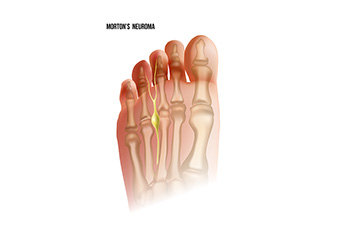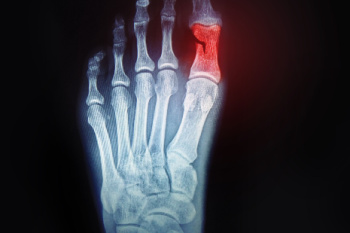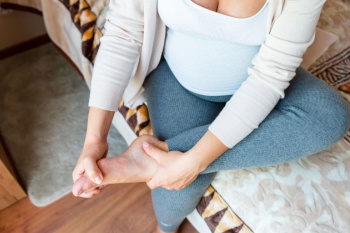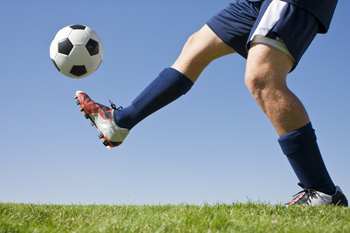Connect With Us
Blog
Items filtered by date: June 2024
Facts About Morton's Neuroma

Morton's neuroma is a painful condition affecting the ball of the foot, most commonly between the third and fourth toes. It involves the thickening of tissue surrounding one of the nerves leading to the toes, causing sharp, burning pain or a feeling of something being stuck inside the ball of the foot. Contributing factors include wearing high heels or tight shoes, which put pressure on the toes and the nerves. Symptoms can also include numbness or a tingling sensation in the toes. Relief methods include wearing wider shoes with lower heels, using arch supports or foot pads, and resting the feet to reduce pressure. In more severe cases, medical treatments such as corticosteroid injections or surgery may be necessary. If pain has developed in this part of your foot, it is suggested that you visit a podiatrist who can provide a proper diagnosis and treatment.
Morton’s neuroma is a very uncomfortable condition to live with. If you think you have Morton’s neuroma, contact one of our podiatrists of Podiatry Care Specialists. Our doctors will attend to all of your foot care needs and answer any of your related questions.
Morton’s Neuroma
Morton's neuroma is a painful foot condition that commonly affects the areas between the second and third or third and fourth toe, although other areas of the foot are also susceptible. Morton’s neuroma is caused by an inflamed nerve in the foot that is being squeezed and aggravated by surrounding bones.
What Increases the Chances of Having Morton’s Neuroma?
- Ill-fitting high heels or shoes that add pressure to the toe or foot
- Jogging, running or any sport that involves constant impact to the foot
- Flat feet, bunions, and any other foot deformities
Morton’s neuroma is a very treatable condition. Orthotics and shoe inserts can often be used to alleviate the pain on the forefront of the feet. In more severe cases, corticosteroids can also be prescribed. In order to figure out the best treatment for your neuroma, it’s recommended to seek the care of a podiatrist who can diagnose your condition and provide different treatment options.
If you have any questions, please feel free to contact our offices located in West Chester, and Broomall, PA . We offer the newest diagnostic and treatment technologies for all your foot care needs.
What to Do if Your Child Breaks a Toe
 Broken toes in kids are common due to their active lifestyles and frequent participation in sports and play. These fractures often occur from stubbing the toe, dropping heavy objects on the foot, or direct impacts during activities. Symptoms of a broken toe include severe pain, swelling, bruising, and difficulty walking or bearing weight on the affected foot. The pain from a broken toe is usually immediate and intense, with visible deformity or misalignment in severe cases. If a child complains of persistent pain and shows signs of swelling or discoloration, a fracture is likely. Treatment for broken toes in children typically involves rest, compression, and elevation to reduce swelling and alleviate pain. Immobilizing the toe with a splint or buddy-taping it to an adjacent toe can help maintain alignment and promote healing. Pain relievers may be used to manage discomfort. If you suspect your child has broken a toe, it is suggested that you schedule an appointment with a podiatrist for a proper diagnosis and appropriate treatment.
Broken toes in kids are common due to their active lifestyles and frequent participation in sports and play. These fractures often occur from stubbing the toe, dropping heavy objects on the foot, or direct impacts during activities. Symptoms of a broken toe include severe pain, swelling, bruising, and difficulty walking or bearing weight on the affected foot. The pain from a broken toe is usually immediate and intense, with visible deformity or misalignment in severe cases. If a child complains of persistent pain and shows signs of swelling or discoloration, a fracture is likely. Treatment for broken toes in children typically involves rest, compression, and elevation to reduce swelling and alleviate pain. Immobilizing the toe with a splint or buddy-taping it to an adjacent toe can help maintain alignment and promote healing. Pain relievers may be used to manage discomfort. If you suspect your child has broken a toe, it is suggested that you schedule an appointment with a podiatrist for a proper diagnosis and appropriate treatment.
A broken toe can be very painful and lead to complications if not properly fixed. If you have any concerns about your feet, contact one of our podiatrists from Podiatry Care Specialists. Our doctors will treat your foot and ankle needs.
What to Know About a Broken Toe
Although most people try to avoid foot trauma such as banging, stubbing, or dropping heavy objects on their feet, the unfortunate fact is that it is a common occurrence. Given the fact that toes are positioned in front of the feet, they typically sustain the brunt of such trauma. When trauma occurs to a toe, the result can be a painful break (fracture).
Symptoms of a Broken Toe
- Throbbing pain
- Swelling
- Bruising on the skin and toenail
- The inability to move the toe
- Toe appears crooked or disfigured
- Tingling or numbness in the toe
Generally, it is best to stay off of the injured toe with the affected foot elevated.
Severe toe fractures may be treated with a splint, cast, and in some cases, minor surgery. Due to its position and the pressure it endures with daily activity, future complications can occur if the big toe is not properly treated.
If you have any questions please feel free to contact our offices located in West Chester, and Broomall, PA . We offer the newest diagnostic and treatment technologies for all your foot and ankle needs.
Understanding Foot Pain During Pregnancy

Pregnancy is a time of profound physical changes, and foot pain can be a common discomfort experienced by many expecting mothers. Several factors contribute to foot pain during pregnancy, including weight gain, hormonal changes, and the body's altered center of gravity. As the uterus expands and the baby grows, additional pressure is placed on the feet, leading to swelling and discomfort. Hormonal changes, particularly increased levels of relaxin, can loosen ligaments and joints in the feet, making them more susceptible to strain and injury. Furthermore, changes in posture and gait due to the shifting center of gravity can put added stress on the feet, leading to pain and fatigue. Additionally, pre-existing foot conditions, such as flat feet or overpronation, may become more problematic during pregnancy. While foot pain during pregnancy is often temporary and resolves after childbirth, supportive footwear, practicing regular foot exercises, and elevating the feet can help alleviate discomfort and promote foot health. If you have developed foot pain during your pregnancy, it is suggested that you consult a podiatrist who can provide you with effective relief tips.
Pregnant women with swollen feet can be treated with a variety of different methods that are readily available. For more information about other cures for swollen feet during pregnancy, consult with one of our podiatrists from Podiatry Care Specialists. Our doctors will attend to all of your foot and ankle needs.
What Foot Problems Can Arise During Pregnancy?
One problem that can occur is overpronation, which occurs when the arch of the foot flattens and tends to roll inward. This can cause pain and discomfort in your heels while you’re walking or even just standing up, trying to support your baby.
Another problem is edema, or swelling in the extremities. This often affects the feet during pregnancy but tends to occur in the later stages.
How Can I Keep My Feet Healthy During Pregnancy?
- Wearing orthotics can provide extra support for the feet and help distribute weight evenly
- Minimize the amount of time spent walking barefoot
- Wear shoes with good arch support
- Wear shoes that allow for good circulation to the feet
- Elevate feet if you experience swelling
- Massage your feet
- Get regular, light exercise, such as walking, to promote blood circulation to the feet
If you have any questions please feel free to contact our offices located in West Chester, and Broomall, PA . We offer the newest diagnostic and treatment technologies for all your foot and ankle needs.
Why Live with Pain and Numbness in Your Feet?
Common Foot Injuries in Soccer

Soccer players frequently encounter foot injuries due to the sport’s high physical demands. Foot blisters are common, starting as irritated skin and developing into fluid-filled bubbles from the friction inside the shoes. Ankle sprains, the most common soccer injury, occur from twisting or impact, leading to ligament stretching or tearing. Wearing tight shoes often cause toenail injuries, and can lead to blood forming under the nail, loose nails, or nails falling off. Turf toe, a painful sprain of the big toe joint, occurs from sudden jamming movements, especially on artificial turf, and necessitates rest and immobilization. Plantar fasciitis causes heel pain, resulting from inflammation of the tissue that connects the heel to the toes, and is considered an overuse injury. Achilles tendonitis affects the back of the heel and can be caused by overuse, inadequate warm-ups, or wearing improper footwear. Foot fractures and stress fractures often result from direct impacts, acute twisting, or repetitive stress during play. If you have sustained a foot or ankle injury while playing soccer, it is suggested that you schedule an appointment with a podiatrist for a diagnosis and treatment.
Ankle and foot injuries are common among athletes and in many sports. They can be caused by several problems and may be potentially serious. If you are feeling pain or think you were injured in a sporting event or when exercising, consult with one of our podiatrists from Podiatry Care Specialists. Our doctors will assess your condition and provide you with quality foot and ankle treatment.
Common Injuries
The most common injuries that occur in sporting activities include:
- Achilles Tendonitis
- Achilles Tendon Rupture
- Ankle Sprains
- Broken Foot
- Plantar Fasciitis
- Stress Fractures
- Turf Toe
Symptoms
Symptoms vary depending upon the injury and in some cases, there may be no symptoms at all. However, in most cases, some form of symptom is experienced. Pain, aching, burning, bruising, tenderness, tightness or stiffness, sensation loss, difficulty moving, and swelling are the most common symptoms.
Treatment
Just as symptoms vary depending upon the injury, so do treatment options. A common treatment method is known as the RICE method. This method involves rest, applying ice, compression and elevating the afflicted foot or ankle. If the injury appears to be more serious, surgery might be required, such as arthroscopic or reconstructive surgery. Lastly, rehabilitation or therapy might be needed to gain full functionality in the afflicted area. Any discomfort experienced by an athlete must be evaluated by a licensed, reputable medical professional.
If you have any questions, please feel free to contact our offices located in West Chester, and Broomall, PA . We offer the newest diagnostic and treatment technologies for all your foot care needs.

